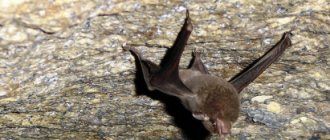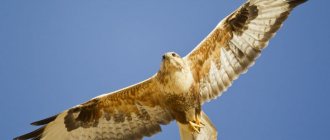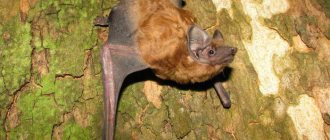- Wild animals
- >>
- Fish
Goblin shark , also known under other names, is a deep-sea fish; it is one of the most poorly studied and ancient sharks. A little verified information about its nutrition, behavior in its usual environment, and reproduction. But something can still be told about this amazing monster of the depths - and this is a very unusual fish!
Origin of the species and description
Photo: Goblin Shark
Of the relict family of scapanorhynchid sharks, this species is considered the only survivor. It is believed - because due to their habitat deep in the water column and sharks, goblins are very rarely encountered by researchers, and therefore no one knows whether the ocean depths conceal another species belonging to this family, or even several.
The first goblin shark was caught in 1898. Due to the unusual nature of the fish, its scientific description was not made immediately, but only after a detailed study, which took about a year, was done by D.S. Jordan. The first fish caught was still young, only a meter long, as a result, at first scientists had the wrong idea about the size of the species.
Video: Goblin Shark
It was classified as Mitsukurina owstoni in honor of Alan Owston and Professor Kakechi Mitsukuri, the former who caught it and the latter who studied it. Researchers immediately noticed the similarity with the Mesozoic shark Scapanorhynchus, and for some time they believed that this was it.
Then differences were established, but “scapanorhynchus” was established as one of the unofficial names. The species are indeed related, and since the real Scapanorhynchus did not survive, calling its closest surviving relative that name is quite justified.
The goblin shark truly belongs to a relict species: it has existed for almost 50 million years, bears many relict features and is therefore very interesting to study. The most ancient representatives of the Scapanorhynchidae family lived in the earth's oceans about 125 million years ago.
Notes
- Synonyms of Mitsukurina owstoni
Jordan, 1898 in the FishBase database (English) - Life of animals. Volume 4. Lancelets. Cyclostomes. Cartilaginous fish. Bony fishes / ed. T. S. Rassa, ch. ed. V. E. Sokolov. — 2nd ed. - M.: Education, 1983. - P. 31. - 575 p.
- ↑ 1 2 Reshetnikov Yu. S., Kotlyar A. N., Rass T. S., Shatunovsky M. I.
Five-language dictionary of animal names. Fish. Latin, Russian, English, German, French. / under the general editorship of academician. V. E. Sokolova. - M.: Rus. lang., 1989. - P. 22. - 12,500 copies. — ISBN 5-200-00237-0. - Gubanov E. P., Kondyurin V. V., Myagkov N. A. Sharks of the World Ocean: A Guide. - M.: Agropromizdat, 1986. - P. 53. - 272 p.
- Compagno, Leonard JV
Volume 2. Bullhead, mackerel and carpet sharks (Heterodontiformes, Lamniformes and Orectolobiformes) // FAO species catalogue. Sharks of the World: An Annotated and Illustrated Catalog of Shark Species Known to Date. - Rome: Food and Agricultural Organization of the United Nations, 2002. - P. 70. - ISBN 92-5-104543-7. - ↑ 1 2 Stevens, J. D. Paxton, J. R.
(1985).
A new record of the goblin shark, Mitsukurina owstoni (Family Mitsukurinidae), from eastern Australia. Proceedings of the Linnean Society of New South Wales. 108
(1): 37–45. - ↑ 1 2 Parsons, G.R.;
Ingram, G. W., Jr.; Havard, R. First record of the goblin shark
Mitsukurina owstoni
Jordan (Family Mitsukurnidae) in the Gulf of Mexico // Southeastern Naturalist (Humboldt Field Research Institute). - 2002. - Vol. 1, No. 2. - P. 189-192. — ISSN 1528-7092. - doi:10.1656/1528-7092(2002)001[0189:FROTGS]2.0.CO;2. - Jordan, D. S.
(1898).
Description of a species of fish ( Mitsukurina owstoni
) from Japan, the type of a distinct family of Lamnoid sharks.
Proceedings of the California Academy of Sciences, (Series 3, Zoology) 1
: 199–202, pl. 11-12. - Stewart, AL;
Clark, M. R. (1988).
Records of three families and four species of fish new to the New Zealand fauna. New Zealand Journal of Zoology (The Royal Society of New Zealand) 15
: 577–583. - ↑ 1 2 Duffy, C. A. J., Ebert, D. A. & Stenberg, C.
(2004). Mitsukurina owstoni. 2006. IUCN Red List of Threatened Species. IUCN 2006. www.iucnredlist.org. - Froese, Rainer, and Daniel Pauly, eds.
Mitsukurina owstoni
(undefined)
. FishBase (2005). Retrieved March 5, 2013. Archived March 10, 2013. - Martin, R.A.
Family Mitsukurinidae: Goblin Shark - 1 species
(unspecified)
. ReefQuest Center for Shark Research. Retrieved March 5, 2013. Archived March 10, 2013. - Jordan, Vanessa.
Biological Profiles: Goblin Shark
(unspecified)
. Florida Museum of Natural History.. Date of access: March 5, 2013. Archived March 10, 2013. - Martin, R. A.
Biology of the Goblin Shark (Mitsukurina owstoni)
(unspecified)
. Sharks. GreenGoblin.com (1999). Retrieved March 5, 2013. Archived March 10, 2013. - A shark from the Pacific Ocean was caught in Crimea - News@Mail.ru Archival copy dated December 28, 2010 on the Wayback Machine.
- YouTube - Goblin Shark from the Black Sea.
Appearance and features
Photo: Goblin shark or brownie
The name itself evokes associations - goblins are usually not known for their beauty. The goblin shark looks scarier than most of them: it was actually nicknamed so because of its unusual and even quite scary appearance - distorted and unusual forms for people are generally characteristic of many inhabitants of the depths, living under conditions of strong pressure from the water column.
The jaws are elongated and can move forward very far, and on the muzzle there is a long outgrowth resembling a beak. In addition, the skin of this shark is almost transparent and the vessels are visible through it - this gives it a blood-pink color, which quickly changes to brown after death.
The vessels are located almost right next to the skin; they are clearly visible, partly because of this. This anatomy not only gives the fish an unpleasant and even frightening appearance, but also allows skin respiration. The ventral and anal fins are highly developed and larger than the dorsal, which makes it possible to better maneuver at depth, but the goblin shark is unable to develop high speed.
The body is rounded, spindle-shaped, which increases maneuverability. Scapanorhynchus is strongly elongated and flattened, and therefore, even with a significant length, its weight is not so large by shark standards: it grows to 2.5-3.5 meters, and its mass is 120-170 kilograms. It has long and sharp front teeth, and the back ones are designed to chew prey and crush shells.
It has a highly developed liver: it weighs a quarter of the fish’s total body weight. This organ stores nutrients, which helps the goblin shark live for a long time without food: even two or three weeks of hunger will not deprive it of all its strength. Another important function of the liver is to replace the swim bladder.
Interesting fact: The eyes of the goblin shark glow green in the dark, like many other inhabitants of the deep waters, because it is very dark there. But she still relies on vision much less than on other senses.
Telescope Octopus Transparent with telescopic eyes
Amphitretus pelagicus is an octopus that is unique for several reasons. Firstly, it is almost completely transparent, which makes it easy to confuse it with a plastic bag. Secondly, it prefers to swim not horizontally, like other octopuses, but hovering in a vertical position, which, by the way, is reminiscent of the Deepsea Challenger apparatus, in which director James Cameron descended to the bottom of the Mariana Trench. Apparently, this is his strategy to evade predators, making it harder for them to spot the transparent creature.
The most interesting thing is his eyes. Amphitretus pelagicus is the only octopus that has telescopic eyes. They move forward quite strongly and help him to have a wide view of the space around him. A true genius of hide and seek and camouflage.
Where does the goblin shark live?
Photo: Goblin shark in the water
The habitat is not known for certain; one can only draw conclusions regarding the areas where Scapanorhynchus were caught.
Goblin shark habitats:
- China Sea;
- the Pacific Ocean area east of the coast of Japan;
- Tasman Sea;
- Great Australian Bight;
- waters south of South Africa;
- Gulf of Guinea;
- Caribbean Sea;
- Bay of Biscay;
- Atlantic Ocean off the coast of Portugal.
Over the entire period, less than fifty individuals were caught, and based on such a sample it is impossible to draw firm conclusions about the boundaries of the range.
Japan leads in the number of goblin sharks caught - it was in the seas that surround it that most of them were found. This, however, is probably due primarily to the fact that the Japanese have well-established deep-sea fishing, and does not mean that it is in these waters that the largest number of scapanorhynchus live.
Moreover: it is the seas and bays that are listed, while the open ocean is probably home to a much larger number of goblin sharks, but deep-sea fishing in them is carried out in much smaller volumes. In general, the waters of all oceans are suitable for their habitat - the only exception may be the Arctic Ocean, however, researchers are not sure about this.
The first individual was also caught not far from the Japanese coast, in this country the species was given the name goblin shark - although it was not used in Russian for a long time. They preferred to call her a brownie - this folklore creature was much better known to Soviet people.
Due to the warming of ocean waters that has been going on for a long time, Scapanorhynchus is gradually changing its habitat, moving upward. But the depths are still significant: this shark prefers to have at least 200-250 meters of water above its head. Sometimes it swims much deeper - up to 1500 meters.
Shark habitat
Predators prefer to live in warm or temperate waters, so the goblin shark can be found in almost all the world's oceans with the exception of the Arctic Ocean. A concentration of these animals was noted near Japan; it was there that the predator was most often caught. The species is present in the waters of New Zealand and North America, in the western parts of the Indian and Atlantic oceans. Found in the Bay of Biscay and Gulf of Mexico.
The fish feels great at a depth of 300 meters, but does not fall below 1300 meters. Due to the general warming of the oceans, the goblin shark began to be found in shallower waters, which is unusual for this species.
What does a goblin shark eat?
Photo: Deep sea goblin shark
The diet is not reliably determined, since the contents of the stomach of the caught fish were not preserved: it was emptied due to a pressure difference during ascent. Therefore, we can only make assumptions as to what organisms they feed on.
The basis for the conclusions was, among other factors, the structure of the jaws and dental apparatus of this fish - as the researchers suggest based on the results of their study, Scapanorhynchus can feed on deep-sea organisms of various sizes - from plankton to large fish. The diet also includes cephalopods.
Most likely, the goblin shark feeds on:
- fish;
- plankton;
- squid;
- octopuses;
- cuttlefish;
- small invertebrates;
- crustaceans;
- shellfish;
- carrion.
To catch and hold prey, it uses its front teeth, and chews it with its back teeth. The jaws are well developed; when hunting, it pushes them far forward, grabs and holds the prey, and at the same time it also strongly draws water into its mouth.
It is hardly able to catch prey that can move quickly, so it is often limited to the relatively slow inhabitants of the sea - it simply catches up with them and sucks them in if they are small, and holds larger ones with its teeth.
If you can’t get enough in this way, you have to look for carrion - the goblin shark’s digestive system is adapted to process it. In addition, the reserves of substances in the liver allow it to live for a long time without food at all, if the search for prey is unsuccessful.
Formidable Hunter
The predator's diet is quite varied. It includes fish, shellfish, octopus, cuttlefish, plankton and various carrion. Since the shark lives at great depths, it is forced to hunt in the dark.
Her vision is poorly developed, and the search for prey is carried out using a special growth, which contains a huge number of receptors that detect electromagnetic pulses.
Sensing prey, the shark swims up to it and, drawing in water, sucks the victim into its mouth. The “monster’s” mouth can stretch greatly.
Powerful jaws, not having a rigid attachment to the skull, easily move forward. With teeth as sharp as an awl, she grabs her prey, leaving her not the slightest chance of salvation.
Features of character and lifestyle
Photo: Goblin Shark
It is poorly studied precisely because of its lifestyle: it lives in deep water, and it is difficult to study this area. Therefore, scientists draw their main conclusions from the few samples that were caught. After studying them, it was concluded that, despite its unusual appearance, this is a real shark, and not a stingray - there were such assumptions before.
Scientists are also confident in the relict nature of this species - although fossil goblin sharks have not been found, they have a lifestyle very similar to that of some species of ancient sharks. This is also indicated by their structure, which is in many ways similar to long-extinct creatures.
Although this is not known for certain, it is believed that they are solitary - at least there is no indication that they form clusters and catch them one at a time. It was not possible to study a living goblin shark even under artificial conditions - the only individual surviving after being caught died a week later, not allowing much information to be collected.
Interesting fact: In fact, the unofficial name was not given in honor of goblins, but tengu - creatures from Japanese mythology. Their main distinguishing feature is a very long nose, so Japanese fishermen immediately came up with an analogy. Since there were no tengu in Western mythology, they were renamed goblins, and in the USSR in the same way - brownies.
Social structure and reproduction
Photo: Goblin shark, aka brownie shark
They are considered solitary predators by analogy with similar species. Pisces come together exclusively during the mating season, the details and duration of which have not yet been studied. It comes once every few years. The rest of the time is spent hunting other inhabitants of the depths, and it is very likely that other representatives of their species too.
Regarding reproduction, scientists can also only speculate, since a pregnant female has never been caught - however, this can be done with a high degree of certainty based on studies of other sharks, including deep-sea ones. Scapanorhynchus is probably ovoviviparous; embryos develop directly in the mother's body.
They appear completely ready for independent life - and it begins immediately. The mother does not care for the fry, does not train or feed them, but immediately leaves them, so they have to hunt on their own and hide from predators - fortunately, there are not as many of them as there are closer to the surface.
Interesting fact: The long, protruding outgrowth, which gives half the “charm” of the goblin shark, acts as an electrolocator. It contains Lorenzini vesicles, which detect even very weak electrical signals and allow them to detect prey in the dark, including stationary ones.
Hatchet fish have glowing camouflage
Hatchetfish is a very apt name. They really look like an ax in shape, and are also very skinny and have shiny scales, which make their surface seem metallic. But the coolest thing about them is their masterful camouflage.
Hatchfish have luminous areas, photophores, which, it would seem, is not the most successful strategy for those hiding from predators. The trick is that the hatchet's photophores are directed downward, they are greenish and glow in such a way that they confuse the enemy. If you look at these fish from the bottom up, they will blend into the surface of the water, since there is also a small amount of light coming from there. Damn clever.
Natural enemies of goblin sharks
Photo: Goblin Shark
At the depths at which this shark lives, it has practically no serious enemies - the lack of knowledge certainly prevents us from asserting this, but the habitat itself, unlike the upper layers of water, is not suitable for large predatory creatures, and Scapanorhynchus is one of the most powerful and dangerous inhabitants of the water column.
As a result, he can feel confident and have practically no fear. Conflicts with other sharks are possible when scapanornhus rises into layers of water that are high for it, and they, on the contrary, descend. But these are clearly not very common occurrences - at least, on known examples of goblin sharks there are no traces of bites from larger sharks.
Skirmishes with other deep-sea sharks can also occur, because there are many such species, but Scapanorhynchus is one of the largest and most dangerous among them, so the main threat lies in fights with representatives of its own species. It is not known for certain that they occur, but they are characteristic of almost all sharks.
Unlike adults, there are significantly more threats for young individuals - for example, other deep-sea predator sharks. However, they live a calmer life than the fry of ordinary sharks, since the living creatures in deep water are generally smaller in size, and they quickly grow enough to not be afraid of almost anyone.
Are they in danger in nature?
No enemies were found among the predators. Even if the shark has ill-wishers, they are unable to greatly influence the population. This species occupies a dominant position in the food hierarchy.
The deep world remains a mystery to scientists. Each of its abode is unique and the goblin shark is no exception. Despite the fact that the predator is not used on the farm and has no practical benefit for humans, it is of high importance for science.











